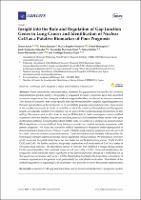| dc.contributor | Vall d'Hebron Barcelona Hospital Campus |
| dc.contributor.author | Sansano Valero, Irene |
| dc.contributor.author | Montero Fernández, Maria Ángeles |
| dc.contributor.author | Romagosa Pérez-Portabell, Cleofé |
| dc.contributor.author | Temprana Salvador, Jordi |
| dc.contributor.author | Martínez Marti, Alexandre |
| dc.contributor.author | Moline Marimon, Teresa |
| dc.contributor.author | Hernandez Losa, Javier |
| dc.contributor.author | Ramon y Cajal Agüeras, Santiago |
| dc.contributor.author | Aasen, Trond |
| dc.date.accessioned | 2019-04-02T11:01:24Z |
| dc.date.available | 2019-04-02T11:01:24Z |
| dc.date.issued | 2019-03-06 |
| dc.identifier.citation | Aasen T, Sansano I, Montero MÁ, Romagosa C, Temprana-Salvador J, Martínez-Marti A, et al. Insight into the Role and Regulation of Gap Junction Genes in Lung Cancer and Identification of Nuclear Cx43 as a Putative Biomarker of Poor Prognosis. Cancers (Basel). 2019;11(3):e320. |
| dc.identifier.issn | 2072-6694 |
| dc.identifier.uri | https://hdl.handle.net/11351/4020 |
| dc.description | Unions comunicants; Immunohistoquímica; Càncer de pulmó |
| dc.language.iso | eng |
| dc.publisher | MDPI |
| dc.relation.ispartofseries | Cancers;11(3) |
| dc.rights | Attribution-NonCommercial-NoDerivatives 4.0 International |
| dc.rights.uri | http://creativecommons.org/licenses/by-nc-nd/4.0/ |
| dc.source | Scientia |
| dc.subject | Pulmons - Càncer - Aspectes genètics |
| dc.subject | Unions de tipus gap (Biologia cel·lular) |
| dc.subject | Connexines |
| dc.subject | Immunohistoquímica |
| dc.subject.mesh | Lung Neoplasms |
| dc.subject.mesh | Gap Junctions |
| dc.subject.mesh | /genetics |
| dc.subject.mesh | Immunohistochemistry |
| dc.subject.mesh | Connexin 43 |
| dc.title | Insight into the Role and Regulation of Gap Junction Genes in Lung Cancer and Identification of Nuclear Cx43 as a Putative Biomarker of Poor Prognosis |
| dc.type | info:eu-repo/semantics/article |
| dc.identifier.doi | 10.3390/cancers11030320 |
| dc.subject.decs | neoplasias pulmonares |
| dc.subject.decs | uniones comunicantes |
| dc.subject.decs | /genética |
| dc.subject.decs | inmunohistoquímica |
| dc.subject.decs | conexina 43 |
| dc.relation.publishversion | https://www.mdpi.com/2072-6694/11/3/320 |
| dc.type.version | info:eu-repo/semantics/publishedVersion |
| dc.audience | Professionals |
| dc.contributor.organismes | Institut Català de la Salut |
| dc.contributor.authoraffiliation | [Aasen T] Grup en Patologia Molecular Translacional, Vall d’Hebron Institut de Recerca, Barcelona, Spain. [Sansano I, Montero MÁ, Romagosa C, Temprana-Salvador J] Servei d’Anatomia Patològica, Hospital Universitari Vall d'Hebron, Barcelona, Spain. [Martínez-Marti A] Servei d’Oncologia Mèdica, Hospital Universitari Vall d'Hebron, Barcelona, Spain. [Moliné T, Hernández-Losa J] Servei d’Anatomia Patològica, Hospital Universitari Vall d'Hebron, Barcelona, Spain. [Ramón Y Cajal S] Grup en Patologia Molecular Translacional, Vall d’Hebron Institut de Recerca, Barcelona, Spain. Servei d’Anatomia Patològica, Hospital Universitari Vall d'Hebron, Barcelona, Spain. |
| dc.identifier.pmid | 30845770 |
| dc.rights.accessrights | info:eu-repo/semantics/openAccess |

